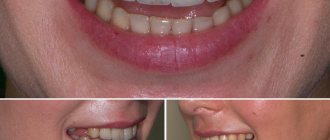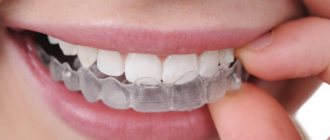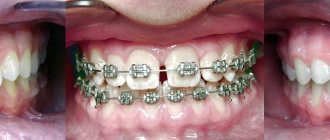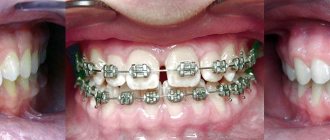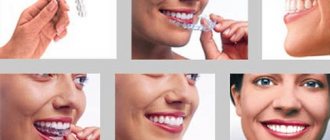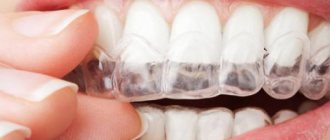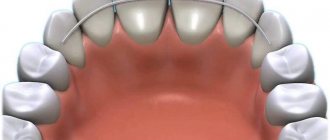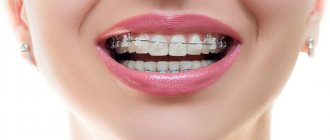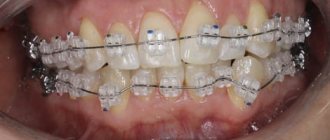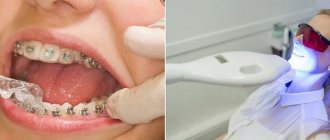In correcting dental malocclusion, the retention stage is very important. It is necessary in order to consolidate the results achieved by wearing braces. While wearing braces, teeth move under pressure. In this case, old tissues are torn and new ones are formed. Once the braces are removed there is no more pressure. There is a risk that the teeth will return to their original position.
Retainers help avoid this situation. They help teeth secure themselves in their new position. As a rule, the retention period lasts 2 times longer than treatment with braces. But the exact period is determined by the doctor depending on the complexity of the clinical case.
Removable retainers
This type of retention structure assumes that the patient can take it off and put it on independently, without the participation of a doctor. Removable retainers used in our clinic:
- retention guards are an exact copy of all elements of one patient’s dentition. Made from transparent polymer material. They need to be worn at night. Before putting on mouthguards, you must brush your teeth, otherwise a nutrient medium for the active reproduction of pathogenic microflora may form on the inside of the structure.
Duration of retention period
The patient always wants to get rid of any structures in the mouth as quickly as possible. The orthodontist always sets the time for wearing retainers individually for each patient. The duration of the retention period depends on many factors:
- for a teenager, the period will be shorter; for an adult over 20 years old, the time of wearing orthodontic systems increases;
- after correcting the bite, the periodontal tissues should be restored; you will have to wear retainers all this time;
- the more complex the malocclusion was, the longer the retention period will last;
- The period of wearing structures directly depends on bad habits; Smokers' teeth can move quickly;
Sometimes orthodontists alternate orthodontic appliances. At the beginning of the period, the patient is fitted with a wire, and at the end of the correctional period, he is asked to wear a mouthguard that can be removed. It all depends on the characteristics of the tooth to move to the side.
Manufacturing and installation of retainers
Our clinic specialists recommend installing retainers after braces immediately after removing the braces. But before that you need to prepare the oral cavity:
- The doctor examines the tooth enamel for damage due to forced improper care during the adjustment period. If defects are detected, appropriate therapy is carried out;
- then professional cleaning is carried out: hard deposits are removed with an ultrasonic scaler, all other deposits are removed with an Air Flow device.
Retention systems are created individually for each patient based on impressions that the dentist takes after the correction is completed. Manufacturing takes 24 hours, after which the client comes to our clinic for installation.
If the patient is prescribed to wear removable products, the doctor shows the fixation process and controls how the patient does it independently. The installation of retainers after fixed braces is carried out by a doctor.
Prices for installing retainers in “Smile” dentistry, as well as the cost of their manufacture, depend on the type of design and the complexity of a particular clinical case. The doctor can name the exact amount only after diagnosis. You can make an appointment by calling the phone number listed at the top of this page or using the self-booking service on this website.
Fixed systems
Fixed retainers are used after the treatment of complex malocclusions. They are installed in a dental office. The orthodontist uses a special glue to fix a metal wire on the inner surface of the teeth. This design is completely invisible and does not cause discomfort while wearing.
While wearing fixed structures, the patient must follow several rules:
- Ensure normal oral hygiene. Teeth with a permanent retainer are cared for in the same way as with braces, so patients do not experience any difficulties.
- Have it professionally cleaned twice a year. The retainer interferes with normal hygiene, so cleaning by a hygienist is mandatory.
- Visit your orthodontist twice a year for an examination. He evaluates the result of retention, checks the quality of fixation of the structure, and secures it if necessary.
Visits to the orthodontist cannot be neglected. After bite correction, teeth tend to return to their original position. If the retainer comes loose, it will happen in about 4 days. The entire treatment result will be lost.
Another type of modern non-removable structures are interconnected lumineers. The advantage of this method is high aesthetics. The smile looks even and beautiful, while lumineers reliably hold the teeth in the desired position and prevent them from moving. When the retention period is over, the structure can be disconnected. In this case, the lumineers remain on the teeth. This method differs from wire retainers in its higher cost, but if the aesthetics of your smile is important to you, we recommend choosing it.
Recommendations for caring for retainers
Our dentists advise carefully monitoring the cleanliness of retention systems to avoid the growth of harmful bacteria on them. Caring for removable and permanent structures varies.
Removable systems should be cleaned twice a day with a toothbrush and toothpaste. In addition, it is necessary to disinfect devices once a week with special products sold in pharmacies. Retainers are removed before treatment.
Caring for stationary retention systems is similar to maintaining braces: they need to be cleaned with a brush, brushes, dental floss, and irrigator. In addition, it is necessary to visit our clinic at least once every 10-12 months for professional cleaning. This will help avoid caries and other dental diseases.
Removable designs: features of wearing and care
Mouthguards are usually made for both dentitions, made from hypoallergenic plastic according to an individual jaw cast. The material is absolutely invisible even from close range, so wearing it during the day at work or school will not cause any problems. The plate is also made from an impression: the plastic base follows the shape of the palate/gums, and the metal arches “hug” the teeth, fixing them. As a rule, plates are used on the upper jaw, but they can also be used on the lower jaw. Compared to other systems under consideration, the aesthetics of the plate cannot be called high.
Removable devices have the following advantages:
- minimal period of adaptation;
- do not interfere with eating, do not impose any restrictions - they are simply removed during meals;
- do not complicate hygiene - again, due to removability;
- easy to care for - clean with a regular toothbrush and periodically wash in a disinfecting solution.
a special container for storage.
. This will keep the devices clean, avoid breakdowns and, accordingly, replacement. The main disadvantage of mouthguards and plates is the need to independently monitor their wearing. Poor discipline of the patient (especially teenagers) and prolonged absences in wearing can negatively affect the beauty of the smile. In addition, in some cases, a non-removable option is more effective, since it permanently holds the teeth, while a removable one is usually worn for a limited number of hours a day. The orthodontist decides which solution will be optimal in a particular case.
The NovaDent dental chain provides a full range of services related to bite correction, including installing permanent structures, ordering mouthguards and plates. We are distinguished by significant experience (the average doctor's experience is 13 years), selection of the most effective therapy for each patient, and attractive prices for retainers in Moscow and the region. In our clinics, the affordable cost of installing retainers to correct a bite is complemented by a flexible loyalty program. In addition, we conduct free consultations, during which we answer all patients’ questions.
Care
When using the product, do not use a toothpick, floss, or whitening paste. A removable dental retainer should be thoroughly cleaned after eating, use an irrigator, and be sure to brush during hygiene activities. In the event of a breakdown, you must immediately contact your dentist to replace or glue an additional segment of the structure.
If a non-removable retainer breaks, a characteristic crunching sound occurs when eating, and the structural element can scratch the tongue. You cannot put off a visit to the doctor - teeth tend to change their position significantly even within a few days.
It is recommended to completely remove the device in case of irreversible damage to replace it with a new one at the end of the required wearing period.
Stages of work
1. Diagnostics
2. Taking an impression
3. Manufacturing and three-dimensional scanning of the model
4. 3D printing of the jaw
5. Making a retainer
6. Installation of a retainer
Indications
- the need to consolidate the result after wearing braces;
- minor bite pathologies;
- inability to use braces to correct the bite (children under 11 years of age).
What can affect the cost?
There are several cost components that must be considered in each case.
- Type of design.
- Cost of materials for manufacturing.
- Use on one or two jaws.
- Additional services (treatment, preparation, rehabilitation, etc.).
- Status and pricing policy of the clinic.
- Region in which treatment is carried out.
Withdrawal cost
We can only talk about the cost of removing retainers if we are talking about non-removable devices. The general concept of “removal” here includes not only the removal of the structure itself from the surface of the teeth, but also the corresponding treatment of the enamel. Of course, this ultimately increases the cost.
The treatment includes cleaning the surface from residual adhesive, grinding, and polishing absolutely all areas that could be affected by retainers. That is why the withdrawal price is quite high - about 10–12 thousand rubles
.
Sometimes the cost of removal from one tooth is also announced if not a metal arch is used, but a special tape. It can range from 3500 to 5000 thousand
.
If you find an error, please select a piece of text and press Ctrl+Enter.
Tags: bite correction, bite retainers prices
Did you like the article? stay tuned
Previous article
Resection of the apex of the tooth root - what happens after the operation?
Next article
Tooth extraction under general anesthesia: reviews, features and cost
Causes of relapses
- excessive tilt of the frontal group units and overstrain of the oral muscles;
- left “eights”, which, when erupting, cause displacement of organs;
- expansion between “threes” - the more it increases, the more rapidly it contracts after correction, which is fraught with crowding;
- rotation of teeth (rotations around an axis);
- violation of the norm for maintaining the natural shape of the mandibular arch - retention devices only in 50-60% of cases repeat its configuration - it tends to return to its original position after 10-12 years;
- jaw growth. If the correction is completed in adolescence, with the vertical type of growth against the background of an open bite, a relapse is possible, and the horizontal type causes a deepening of the incisal overlap with age, therefore such anomalies require observation until the patient is 20 years of age;
- unresolved deviations in the articulation of the tongue when chewing food and swallowing;
- poor quality correction. With severe crowding, no space was created in the row, which led to the units tilting forward; after correction, a significant gap remained between the lower/upper incisors, which caused the upper teeth to return to their original position.
To prevent relapse, you must follow all recommendations, maintain discipline, and see an orthodontist once every six months. If displacement cannot be avoided, the dentist will suggest suitable re-treatment options.
Conditions for successful retention
:
- identifying the causes and factors that provoked the orthodontic defect. If they are not eliminated in time, there will be no lasting result - the teeth will become crooked again;
- competent correction. An inadequate therapeutic regimen or errors when correcting a bite with a brace system can cause unstable location;
- optimal design of the retention system.
